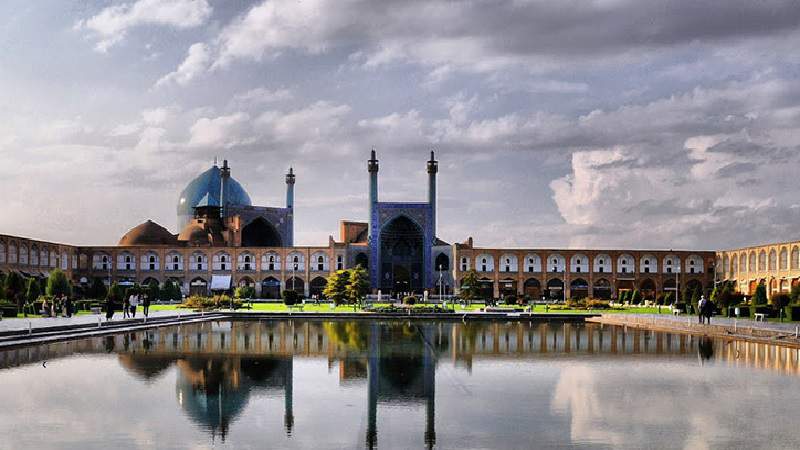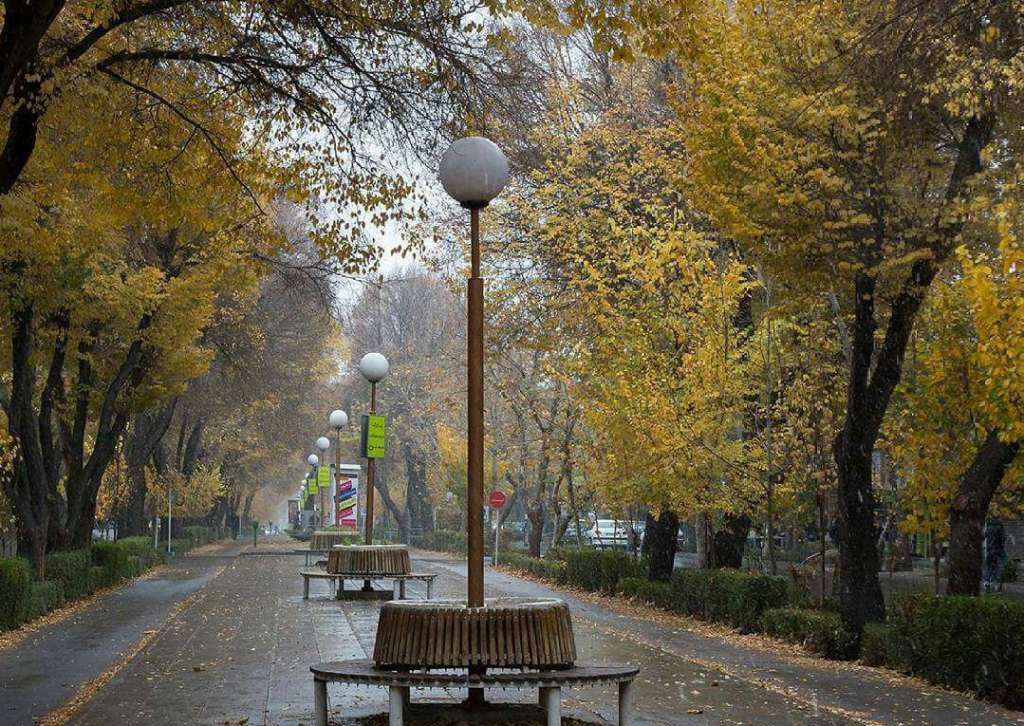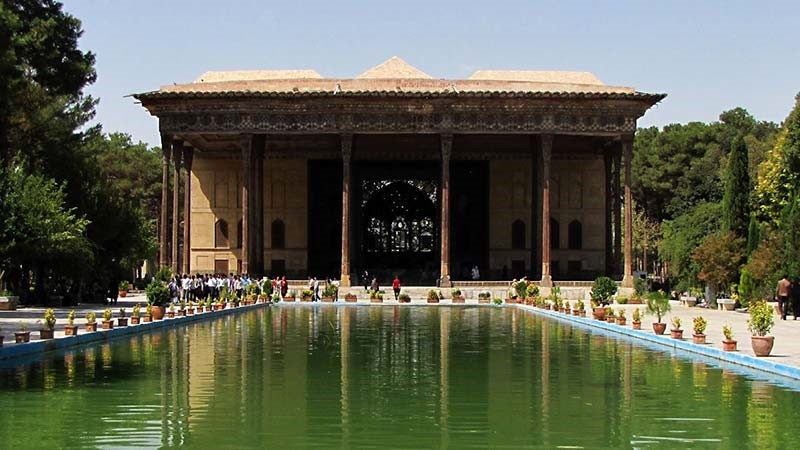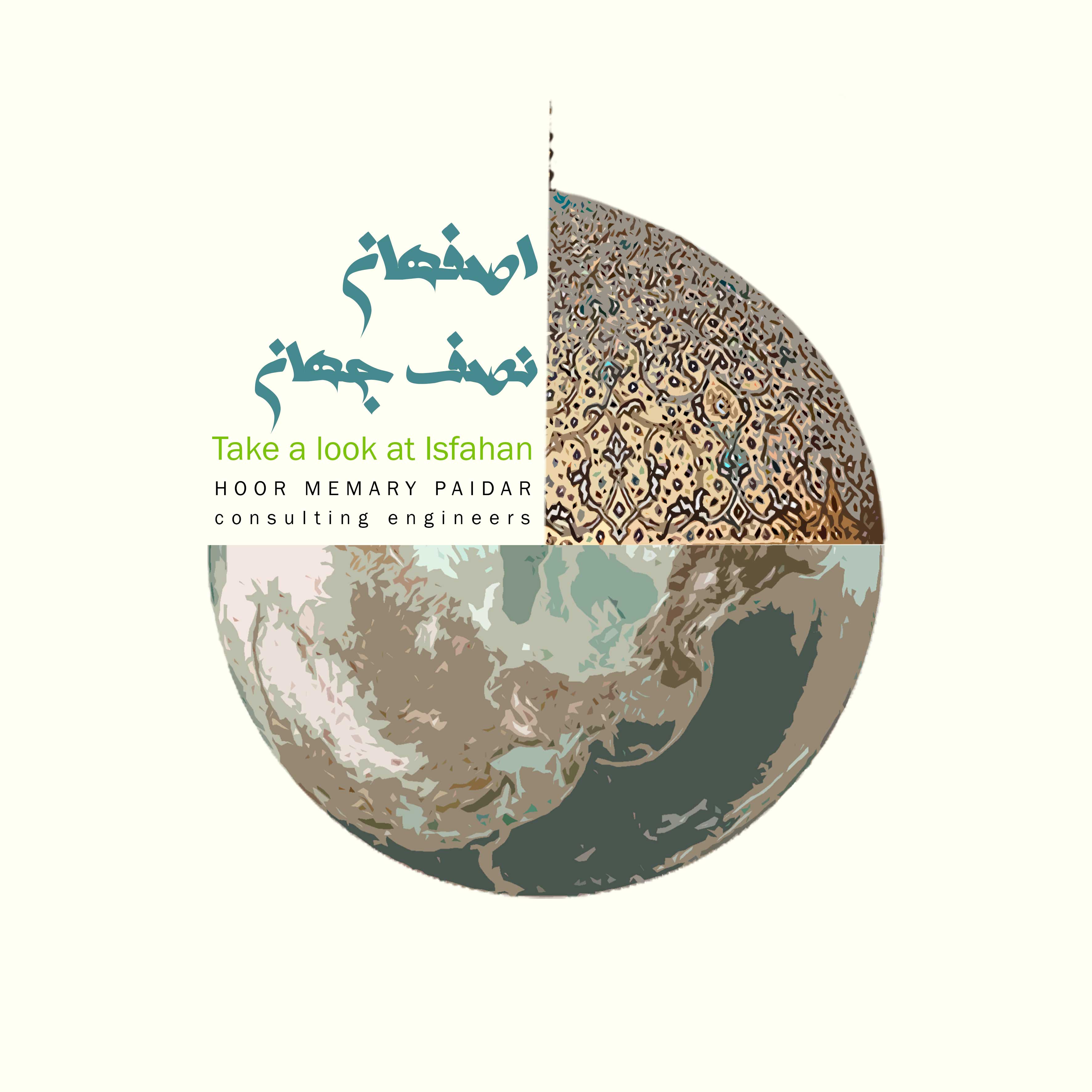
Isfahan is an ancient city in central Iran. This city is the center of Isfahan province and also the center of Isfahan city. Isfahan is Iran’s third most populous city after Tehran and Mashhad.
It flourished between 1050 and 1722, especially in the 16th century, during the Safavid rule, when it became the capital of Iran for the second time (after the Seljuk era). Even today, the city has retained much of its past glory. There are numerous monuments in the city, some of which are registered as UNESCO heritage sites.
Isfahan has been selected as the cultural capital of the Islamic world in 2006 and in 2009 as the capital of Islamic Iran’s culture and civilization as well as the industrial capital of Iran after Tehran. The city is famous for its beautiful Islamic architecture and many beautiful boulevards, covered bridges, beautiful tunnels, palaces, mosques and unique minarets. Isfahan has led to half of the world being recognized in Iranian culture. It joined UNESCO in December 2015 along with Rasht as the first Iranian cities to join the Creative Cities Network of the World. According to UNESCO standards, the creative city is a city that utilizes citizens’ innovations and capabilities in sustainable urban development.
The Naghsh e Jahan square is one of the largest in the world and it is a prominent example of Islamic architecture registered by UNESCO as a World Heritage Site. Isfahan’s motto is “Esfahan Forever, For All”. We will introduce you more to Isfahan.
Geographical location
Isfahan is a relatively high mountainous area with an area of 197,403 km2; including Chahar Mahal Va Bakhtiari located in the center of the Iranian plateau. The city is bounded on the north by the Kashan and Golpayegan districts, on the south by Abadeh and Behbahan, on the east by Yazd, from the Maghreb to the Bakhtiari and Khuzestan districts. It extends from Zard Kooh Mountain in Bakhtiari Province, which is the source of the river, to Gavkhuni Lake; it’s mentioned approximately 300 kilometers wide from the northern Qahrood Mountains to the Amin Abad Village, which is 240 kilometers south of Fars.
City limits
Isfahan is bounded on the north by Ardestan and Kashan and Golpayegan, Shahreza on the south, Nain on the east, and Friedan on the west.
Isfahan today is located in the green plain near the Zayandehrood and its length is 18 km from east to west and 12 km from north to south. Mafarokhi Isfahani in the fifth century AH has described the city’s length and width as 14 par sang in 6 par sang with 8 gates, and stated that it has 800 sheds and farms.
Climate
Heights near town
The sequence of the highlands of Shah Lenjan, south of Isfahan, is connected by two low-lying mountain ranges, Sofe and Baba Said, with a direction from the south to the east. The height of Mount Sofe in south of Isfahan city is 2400 meters. This mountain with its many cuts and because of its proximity to the city, has added to the beauty of Isfahan’s nature. In 25 kilometers northwest of Isfahan is the Seyed Mohammad Mountains, which starts along the Isfahan road and connects to the Kroon, Qumishloo and Alavi Mountains. The mountain has two or three springs. One of them is known among the locals and is one of the promenades of the city is called Cheshmeh Manzar.
The northern highlands of Isfahan are sand dunes that connect to the Madar Shah Canyon in Isfahan-Tehran three ways and end to the Chaleh Siah Mountain from 35 km northwest of Isfahan.
A little farther, the northern plain of Isfahan is bordered by the Natanz and Gharoos mountains of Kashan and the famous Karkas Mountain, 3350 meters high in a straight line, is located 50 kilometers north of Isfahan, which is often covered with snow and is visible from afar due to its elevation.
Weather

In terms of the order of the four seasons of the year, none of the Iranian cities equals Isfahan. The first day of Farvardin, the first of Tir, the first of Mehr and the first of Dey announce the start of the four spring, summer, autumn, and winter seasons, with rare changes.
In the middle of Mehr, the weather tends to get a little cold. The people from ancient times are called the night of 17th of Mehr Jolband and from that night on, it are likely that the cold will damage some crops that are on the tree or may not reach. Late Mehr until mid-Aban is the start of fall and leaf fallen season of Isfahan and then there is no fruit in the tree or the field, and everyone is picked and stored. It usually starts raining in early Aban and on the first Azar all the leaves of the trees are shed and the trees are dried like wood. In late Azar, the weather is quite cold and there is a chance of snow and frost and it is called Chehleye bozorg and from the 10th of Bahman to the first of Esfand, the cold weather is invalid unless in exceptional years when the cold weather is high and it is called Chehleye koochak. The weather is warm since early Esfand and it is warm and temperate in the first of Ordibehesht and in the first of Khordad the warmth of weather increases but not overwhelming. From this month to early Tir when the weather reaches its warmth, it is beginning to harvest fruit trees in Isfahan.
Isfahan’s climate is mild due to the abundance of trees and water vapor coming from Zayandehroud and its softness and freshness is especially noticeable in the spring. Predatory fruits, such as cucumbers, are harvested from thirty to forty days after Nowruz and their grains from 120 days after Rabiee’s moderation.
Zayandeh rood
The most important river in central Iran is Zayandehrood, Originating from the Zardkou Bakhtiari heights and from a field called Koohrang, it flows from west to east to the Gavkhuni marsh. The length of the river with its mazes is 400 to 480 kilometers, but the distance to the straight line is 270 kilometers. The width of the riverbed rises to 200 meters.
Rangelands and forests
In most parts of Isfahan rangelands are used for shepherds, the most important are:
1-In Chahar Mahal, there are 31 patches of grass, the most important is Gandoman.
2-In Friedan, many rangelands are found and from different parts of Isfahan, sheep are brought to these rangelands from early spring to mid-autumn. The most important are Meydana, Chehel Cheshmeh, Shahneshin.
3-In Shahreza: Amin abad ,Ghasre chaman , Ab dozd,Mahyar.
4- There are also meadows in Carvan.
There are numerous forests in Friedan, and their crops are trees like:Kaboode,Poplar.Tabrizi and crops like Sumac and barberry, peanut and walnut.
Reason for naming Isfahan
Isfahan city since ancient times by the name of:Apadana,Asef han, Esbahan, Esba han,Espatna, Espadna,Espahan, Aspedan ,Aspedaneh, Espehan, Espiner, Esfahan, Esfa han, Esbahan, Esba han, Espedaneh, Esfahan, Esfahan,Esfahank, Enzan, Besfahan, Partak, Park, Pari, Paritakan, Partikan, Jey, Daralyahoodieh,Rashoorjey, Sepahan, Sepaneh, Shahrestan, Safahan,Safahoon, Gaba, Gabian, Gabieh, Gabi, Gey, Nesfe jahan and Yahoodieh was notable.
Most writers believe that since this area before Islam, especially in the Sassanid era, was the center of gathering of the Corps Recruitment and the southern Iranian troops, such as: Kerman, Fars, Khuzestan, Sistan, … gathered in this area and were moving to the battlefield said it (Espahan), then Arabicized it and made it (Isfahan).
It has older vocabulary that has no connection with its current name, such as: Enzan, Gabian, Gabieh, Jey, Gabi, Gey, Gaba.
Yaghoot hemavi writes: \” Isfahan, or Espahan, is from Asbah, which means the army and the dog. \”
\”The value of this derivation is only to prove that in the old Esfahani dialect, asbah was also mean dog, \” says Professor Pordawood.
Pordawood has mentioned that Ptolemy, the geographer of the second century AD, named the city (Spadan), then says that the word Isfahan was placed on the Spahan, which includes (Sepah), which means the army, and (Han) the name of the place which means corps place.
The author of the book Hodood al-Alam mentions this city as (Sepahan), saying: In the Achaemenid Persian inscriptions, Anzan included the area of Isfahan. And before Cyrus, the Achaemenid power center was in this area, and after Cyrus, Anzan became Gabian and Straben has called it the same, and Gabian gradually changed to Jay.
Herzfeld writes: Isfahan was the name of a block from Prith Kahn and the name of the city (Gabi). Gabi later became (Gey) and then Arabic and became (Jey).
In the 2nd century AD, the names Gabi and Espedana appear on the map of Ptolemy. He had gained the Persian (Espedana) Achaemenid persian from the book of Artestans, the director of the Alexander of Macedonia Library. In a world map drawn 100 years before Ptolemy, this name is written in Sasanian (Sepaneh) meaning Sepahan,and the meaning is place of army.
Ibn Asir writes in the book Al-Labab: Isfahan is the city of Belade Jebal it is said Esfahan because its represent Sepahan and the word Sepah means the army and the word Han is the symbol of the crowd and here was the gathering place of the Acacia Corps.
Hamzeh Isfahani believed that the word Isfahan or Espahan was taken from the word Sepah, which means in Persian army and dog.
Lockhart also believed that from the days of the Parthian, the term Spahan had been applied to this area.
The discourse goes on to say that the name was associated with the Revolutionary Guards and that it may have played such a role (Jey), not (Yahoodieh) that its expansion has created the current Isfahan.
In ancient Persian, the word (Sepah) also means horse, because the horse was part of the work of the Revolutionary Guards, as the Yaghoot Hemavi says, the army is equal to horse, and for this reason Isfahan considered the position of the troops. The horse has been valued and respected by the Aryans, and many Iranian celebrities and elders have been named horses (Asb), such as: Gashtasb,Lohrasb,Jamasb that these all names have word (Asb).
History of Isfahan
It is not easy to trace the history of Isfahan throughout history. Although Esfahan was located in the center of the Iranian plateau, because in the pre-Islamic era the focus of the Achaemenid to Sassanid monarchies was the western territory of these empires, and especially Mesopotamia, The city was not the focus of these dynasties. . Throughout the history of the Islamic era, the current location of Isfahan can be traced to different cities under different names, different places and even different people.
Ancient Jey
The building of Isfahan has been attributed to Tahmurth, the third king of the Pishdadian dynasty. Isfahan has been introduced in ancient history with the name Gay in Pars and It is also referred to as Gabai or Tabai. It was also the intersection of major roads and the royal residence of the Achaemenid kings. Greek geographer Strabo has named Isfahan as the center of Iran.
Yahoodieh
When Cyrus the Great captured Babylon and saved the Jews from the captivity of King Nebuchadnezzar of Babylon, a number of Jews returned to Palestine and a number of them came to Iran and they settled there named Dar al-Hahoodiyyae. This area was next to the Jey district which was later linked to form the city of Isfahan.
Ibn Faqih Hamadani, an Iranian historian of the tenth century, writes: When the Jews emigrated from Jerusalem and fled to Nebuchadnezzar, they took with them some of Jerusalem’s soil and water. They did not settle anywhere without testing soil and water before. They continued to reach Isfahan. There they rested and tested its soil and water and found it similar to Jerusalem. When they settled there, they began planting on the ground and gave birth to their children and grandchildren and today this area is called Yahoodieh. This narrative has also been repeated by other historians such as the founder of Khorenatsi, al-Atsakhri, Ibn al-Hooqal, al-Moqadasi, Yaqut Hamawi, Abu al-Fada, and Ibn Khaldun.
Sassanid era
Under the command of Yazdgerd I, a cautious military garrison was established to train and dispatch auxiliaries during the Sassanid era, in addition to the garrison there were three military centers in Marv, Gorgan, and Tisphon. These centers had a fixed force, and only Sepahan had been designated to train and dispatch auxiliary forces.
The current Isfahan was formerly called Gabai (Jey) and was originally the center of the Perthacen tribe (from which the name Friedan remains). The name Espahan (meaning army station) seems to have been replaced with Jey by the Sassanid era. According to legends, the Sassanid cavalry were stationed in the grasslands around Espahan, especially in the western part of the city, as far as the slopes and springs of Zayandehrood during peacetime. Espahan gained concession from the cities of Iran at that time, since he was the Crown Prince of the Sassanids. At the time of the Sassanids, sometimes Espahan and sometimes Armenia was the crown prince of the Persian Empire but Espahan also had the privilege of being the seat and territory of the influence of the Vaspurhans or members of the seven great Iranian families who had influence in the kingdom. However, during the Islamic era, the geographical area around the city retains the name of Aspahan, which was the name of the Sasanian government segmentation. At the time of Alexander the Great’s invasion of Iran, the city was the center of Gabios and it was named Tabay or Gabay. It is commonly thought that the Sassanid part of Isfahan, called Jey, was created by Khosrow I. Therefore, the presence of Jews in this area may have been prior to the Sasanians.
The first Islamic centuries
In the early Islamic centuries, Islamic sources refer to two cities in the current location of Isfahan; a town called Jay in the present location of Jay’s neighborhood and another town about three kilometers west of Jay, named Yahoodieh with a significant Jewish population. The name Jey was later changed to \”Shahrestan\” and Yahoodieh is also referred to Johoodestan.The Arabs conquered Espahan in the year 23 AH and, like other Iranian cities, was under Arab rule until the beginning of the fourth century AH. At the time of king Mansour Abbasi, a large palace was built in the village of Khashinan (present-day Ahmadabad), and a barrage was drawn around Isfahan, and Khashinan was attached to Jouybara (Yahoodieh).
Deylamian
In the year 319 AH. Mardavij Ziyari released Esfahan with his troops from Gilan, and he chose this city as the capital and he celebrated the Sedeh in the city with great glory. In 327 AD, the city was taken over by Rokn al-Dawlah Deilami, who also made Isfahan its capital. After that, the city of Isfahan regained its former progress and became the focus of the gathering of scholars and poets.
Seljuk period
In the spring of 442 AH, Tughrul of Seljuk triumphed Isfahan after a long and devastating siege. However, the city was soon rebuilt under the rule of Abolfath Mozafar Neyshaburi, which was attributed to the government of Isfahan by Tughrul , 500,000 dinars were spent on building and no taxes were levied on people for three years . Rapid urban development brought people back to the city during the conflict; Tughrul also transferred the capital of his government from Rey to Isfahan. The expansion of the city continued during the time of Alb Arsalan,but it was during the reign of King Malikshah and his minister, Khajeh Nizam al-Molk al-Tusi, that the city reached its peak so that the city’s population doubled and many buildings were built there.
Safavid period
In the year 1006 AH, Shah Abbas Safavi transferred the Safavid capital from Qazvin to Isfahan, the author of Alam Aray e Abbasi said the reason for this transfer is Shah Abbas’s interest in Isfahan’s nature. Avoid borders, lowering the power of the Ghezelbashan, improving trade, and the fear of Shah Abbas of prophets who considered his stay in Qazvin dangerous to his life were other reasons for the move. The choice of Isfahan as the capital by Shah Abbas has produced positive results for the city, many mosques, water warehouses and inns were built in the city, at the initiative of Sheikh Baha’i, complete irrigation and communication networks were created, and by founding the city of Najaf Abad in west of Esfahan to provide food for the city, solid agricultural infrastructure was established for the new capital.
Isfahan was the most dominant city in the Middle East during the days of Shah Abbas I until the death of Shah Abbas II. At this time, with the addition of the four neighborhood quarters (Abbasabad, Jolfa, Gabrabad and Espahan), the view of the Safavid capital was even greater and more beautiful than Constantinople. And in its heyday, Isfahan had 137 palaces, 162 mosques, 48 schools, 273 baths and 12 cemeteries.
The Safavid era is considered one of the brightest ages of Iranian art and architecture because in all areas, from its architecture and decoration to music and philosophy, Iran has witnessed significant growth and prosperity.
At this time, because of the great need for urban development and construction, the magnificent mosques were next to the palaces and other urban buildings such as schools, baths, markets and inns were also of great interest. The most important examples include: Isfahans Imam mosque, Sheikh Lotf Allah mosque, Naghshe Jahan square, Ali Qapoo palace , Hasht Behesht palace and etc.
Esfahani style is the latest type of traditional Iranian architecture, and there are two periods, the first of which dates back to the time of the Qaraquiunloos. This method, as its name implies, starts from the city of Isfahan and is considered. Isfahan has a long historical history due to its specific geographical location according to theories, its history goes back to pre-Islamic times. The city was probably the residence of the Achaemenid kings. This method started a little before the Safavids came from Quraidunloo time and at the end of the time of Muhammad Shah is the time of regression (decline) of the Isfahani method, It actually started in the Afsharid period and ends in Qajar, its first period.
Isfahan style features
- Simplify designs in most buildings, spaces are squares or rectangles.
- In Azeri style, using a strong geometry, complex designs were made, but in Isfahani style, simple geometry and more shapes and broken lines were used.
- In the building blocks, the nozzles were reduced, but with this method of building the corners of the building became more common.
- Pimping and utilizing the same organs and sizes in the building were also pursued.
The simplicity of the design was also evident in the buildings.
Qajar period
Massoud Mirza Zel Al Solltan (son of Nasser al-Din Shah Qajar) became ruler of Isfahan in 1288 and in the following years he was also given the rule of Fars, Kurdistan, Lorestan and Yazd. He always wanted to have a personal military force. In Isfahan he formed military vigils with the clothes and arms of the Austrian army and he hired military teachers from Germany to teach them. Nasser al-Din Shah, fearing the tyranny of the Zel Al Solltan in Isfahan, ousted him from all his rule overnight, leaving him the only Isfahan city.
The thirty-four-year rule of Masoodmirza Zel Al Solltan over Isfahan was accompanied by the destruction of more than 50 monuments and Persian gardens in the city. A European tourist at the time wrote:
Unfortunately, Zel Al Solltan has nothing left of the spectacular and charming Chahar Bagh street like other antiquities, he fills the street in stone and sells them on the fringes, and has erased paintings of arches and walls. It has also occupied empty Safavid palaces and mansions by creating cucumber and cantaloupe fields.
Lord Karzen, who came to Iran in the final years of the Qajar rule, writes of these ruins:
The mosque and the royal mansion of Isfahan were stunned. That Haft Dast , the Namakdan and the Aiineh Khaneh mansion with wired maps and large transparent mirrors and integrated ponds carved from clear flat marble and built by the sultans at great expense are all ruined and replaced with a gloomy mound.




